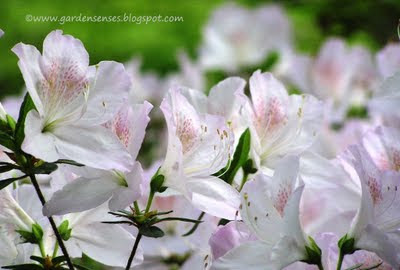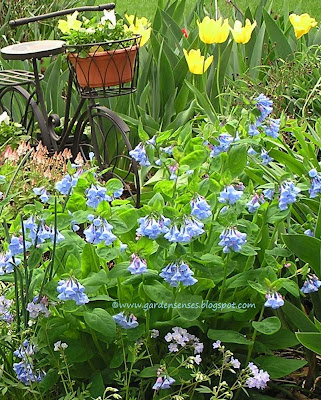Azaleas
Azaleas and Rhododendrons certainly
light up the spring garden.
For some, they may be a bit too electric.
If you're looking for spring flowering shrubs
with a more subtle show,
check out these options.
Rhododendron
The airy white flowers of Slender Deutzia (Deutzia gracilis) are
effective for a number of weeks.
effective for a number of weeks.
Deutzia gracilis 'Nikko' is a dwarf variety which
maintains a height of about 2 feet with a spread of 2-5 feet.
Deutzia can be grown in full sun to part shade.

Slender Deutzia close-up.
White flower spikes cover the evergreen
Cherry Laurel (Prunus laurocerasus 'Otto Luyken').
Plant Cherry Laurel in full sun to part shade.
Variegated Weigela (Weigela florida var.)
branches, laden with flowers,
arch gently toward the ground.
branches, laden with flowers,
arch gently toward the ground.
For best flowering, site Weigela in full sun.
Weigela
Weigela 'Wine and Roses' has purplish foliage .
It's easy to see where
Bridalwreath Spirea (Spiraea x vanhouttei) got its common name -
pristine white flowers trace arching brances
to create quite a spring show.
to create quite a spring show.
Bridalwreath Spirea flower clusters.
Best in full sun, Bridalwreath Spirea tolerates light shade.
Best in full sun, Bridalwreath Spirea tolerates light shade.
Dwarf Fothergilla (Fothergilla gardenii) has moderately effective spring flowers.
Dwarf Fothergilla grows in full sun to part shade.
Feathery Dwarf Fothergilla blooms.
The vibrant yellow-orange flowers of
seemt to glow on the casual-looking,
Japanese Kerria (Kerria japonica 'Pleniflora') shrub.
Grow Japanese Kerria in part shade to shade.
Sunny Japanese Kerria flowers.
but are short on space, consider
Miss Kim Korean Lilac (Syringa pubescens subsp. patula 'Miss Kim').
Miss Kim is a compact variety with good mildew resistance.
Lilacs bloom best in full sun, but tolerate light shade.
Showy white flowers perched along horizontal branches
create a splendid display on
Doublefile Viburnum (Viburnum plicatum var. tomentosum).
Doublefile Viburnum grows in sun to part shade.
Doublefile Viburnum flowers
For more spring flowering plants, see
















































